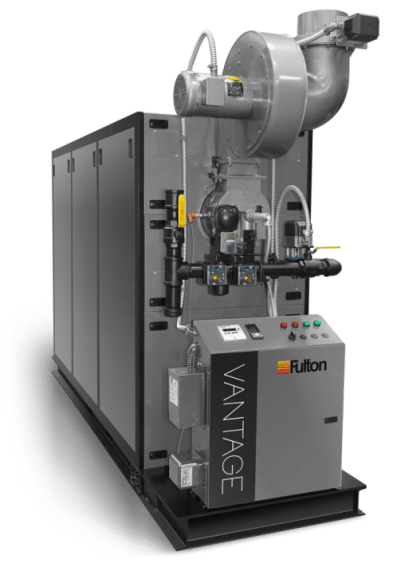Condensing boiler systems are now dominating the landscape of the HVAC industry. These systems can achieve up to 98% thermal efficiency– around 18% higher than non-condensing boiler systems– saving energy, money and contributing to equipment longevity. One key to achieving peak efficiencies and maximizing the potential of a condensing boiler system is to make sure that the return water temperature is set correctly.
The process for condensing and non-condensing boilers begins similarly: inside of a boiler, water is heated via burning fuel. Electric pumps push the heated water through pipe circuits which in turn, heat a radiator. The radiator then disperses heat and warms areas in a building. As a result, water that returns to the boiler system at the end of the cycle is significantly cooler than when it began. In traditional (non-condensing) boiler systems, heat is lost due to excess flue gases pass through a chimney. Condensing boiler systems utilize heat exchangers to recycle heat and energy that would normally be lost during that process.
There are two transport pipes in condensing boiler units: the flow and the return pipe. The flow pipe transports heated water through a system to the radiators. A return pipes guide the remaining water (after heat dispersal) back to the boiler to be reheated. Before the water reaches the boiler, condensing units have heat exchangers that capture and reuse any latent heat. This means that less additional energy is needed to rewarm the water.
The temperature of the return water is crucial to increasing efficiency. The return water in condensing boiler systems needs to be far cooler than the dew point for flue gases to condensate. When condensation occurs, latent energy is transferred to the hot water, essentially creating a warming loop. If temperatures are too high, condensation will not occur.
While it may seem counter-intuitive, a lower water return temperature makes reheating and recycling energy more efficient. While traditional (non-condensing) boiler systems require water return temperatures to be higher than the condensing temperature of the flue gases (to avoid corrosion) condensing boiler systems using heat exchangers are now built to withstand condensation. There is no need to worry about potential equipment damage as a result.
Lower water return temperatures are achieved by lowering the hot water supply temperature set point. A return water temperature of 80°F will create the most efficient performance for most condensing boiler systems.
UEP has an extensive line of condensing boiler systems that can greatly improve heating efficiencies for your projects. Contact us today!




